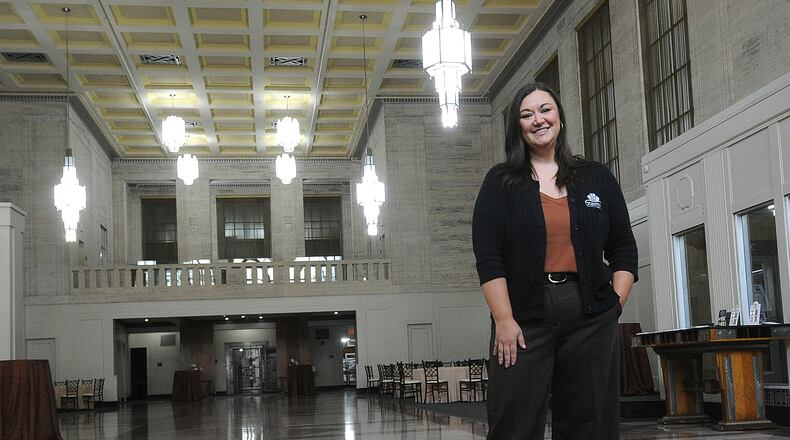Data from the Downtown Dayton Partnership shows vacancy rates varying among the core business district’s 11 biggest buildings from 97% — only 3% of Key Bank Tower is occupied — to just 6% at Liberty Tower, which boasts an occupancy rate of 94%, the highest among downtown’s biggest buildings.
In June, KeyBank officials said the company will vacate its namesake tower downtown. The company said those offices will move further down Second Street to the 130 Building at 130 W. 2nd St., also downtown.
It’s not just Dayton’s downtown being challenged, of course.
Rising interest rates and a global revolution in post-pandemic work habits stressed offices nationwide and globally in ways no one predicted only a few years ago.’
Chris Riegel, founder and chief executive of digital signage and customer outreach technology firm Stratacache, sees downtowns and city cores all over the world.
“Dayton, because it’s a mid-sized or smallish city compared to the big ones, has not suffered nearly as much,” said Riegel, who owns Stratacache Tower, the former Kettering Tower, downtown’s tallest office building.
“But we have to keep our eye on the ball and continue the progress,” he added.
According to partnership data, Stratacache Tower has a 55% occupancy rate. In an interview, Riegel said the true number is closer to 65% and will soon be higher once new leases are finalized.
Downtown Dayton offers a solid value proposition, said developer Jason Woodard, who has enjoyed notable success both independently and with partners in projects close to the Great Miami River and the ballpark.
“It’s kind of a hidden gem,” Woodard said of Dayton’s downtown. “Generally, affordability is significantly better than the major metros. You can be in Columbus in an hour, in Cincinnati in 45 minutes, go see shows, sports, whatever. And there’s a lot to do here.”
Looking beyond offices, downtown Dayton is enjoying strong development attention, both in business and residential arenas.
Downtown saw a 113.78% increase in residences since 2010. The locale had 951 apartments and condos in 2010 — and has 2,033 now, according to the Downtown Dayton Partnership.
Another 705 new residences are in the pipeline today, with 484 of those currently under construction, according to the partnership.
That undeniable growth is clouded by hybrid work, however.
According to a July 2023 McKinsey report, hybrid professional habits are here to stay. Office attendance appears to have stabilized at 30% below pre-pandemic norms, McKinsey said.
The report estimates that some $800 billion may be wiped out from the value of office buildings in nine big cities by 2030 in one hypothetical scenario. (The consultancy did not examine the situation in Dayton.)
If there’s a key to strengthening downtown offices, it lies in giving employees reasons to physically come to work, keeping tenants happy with building features and competitive leases, and adapting to the post-pandemic world, property managers and building owners told the Dayton Daily News for this story.
The Grande Hall at Liberty Tower
Five years ago, Jenna Kreitzer and her colleagues were forced to get creative at 92-year-old Liberty Tower, 120 W. Second St., where she is director of facilities and property management.
In 2018, Kreitzer found herself with 24,000 square feet of vacant first-floor space that had been used historically for retail banking, a quickly changing sector.
With high-arched windows, art deco grandeur straight from the 1930s and 35-foot-high ceilings, the space begged to be used in some capacity. But how?
Liberty Savings bought the bank in 1998. In 2011, Liberty sold its Ohio retail locations to First Financial, while retaining the downtown building.
But First Financial did not need the entire first floor space for banking.
“We realized that the more people we could get in to appreciate the architecture, the better it was for the building — and the better it was for downtown,” Kreitzer said. “So essentially, the owners and I were thinking through what to do with the space, and we kind of landed on events.
Credit: Tom Gilliam
Credit: Tom Gilliam
“Because events were going to happen, no matter what the economy is,” she added. “They might look a little different. The budgets might look a little different. But people are still getting married. Corporate parties are still happening, but on a smaller scale.”
And they did happen. The space has hosted weddings, receptions, holiday corporate parties and other corporate events.
The remodeling took about a year. But Kreitzer says the work has paid off.
“It has been a success,” she said. “We’ve had some pretty incredible years, particularly post-COVID.”
“The tenants are happy here,” said Ed Wiles, building engineer at Liberty Tower, who has worked in the building for 32 years. “They’re getting good service. And the infrastructure is up to date. That’s a big thing, for comfort.”
“People are starting to get creative,” said Alaina Geres, director of economic development for the Downtown Dayton Partnership. “They understand they can’t just fill all these offices with just office use.”
Meeting people where they are
Many companies are trying to decide what they’re going to do long-term with space, said Dave Dickerson, president of business development at Dayton construction business Miller Valentine.
“A lot of the leases are expiring,” he said. “A lot of the companies are taking less space. I think everybody is still in a wait-and-see (mode), trying to figure out what the return to work full-time will look like.”
The real challenge for companies is maintaining a culture that honors business goals while retaining valued employees, he said.
Credit: Jim Noelker
Credit: Jim Noelker
Dickerson pointed to the example of the Premier building downtown.
In January, Premier Health, one of the region’s largest employers, said it would sell its office building in the heart of downtown Dayton, while continuing to lease some space at the 110 N. Main St. site.
While some workers returned to the office as COVID restrictions waned, the vast majority of Premier Health’s downtown work force continued to work remotely either full-time or at least part-time, company officials said when they announced their intention to sell the building.
“Their building has been vacant because a lot of their people are in a flex mode of working,” Dickerson said, referring to Premier. “That’s just one example.”
Joann Ringer, chief administrative officer of Premier, confirmed that when pandemic restrictions lifted, not everyone returned to the office.
“We’re meeting people where they are,” Ringer said.
Premier has not yet sold the building, she said in a September interview. And Premier will continue to be a tenant even after the sale.
There is some prospective buyer interest, but Ringer declined to discuss that at length.
While Dickerson said he sometimes hears that there is “too much” office space in the Dayton market, he isn’t so sure.
In the future, more space may be needed, he believes.
“Downtown is doing well, but the office piece is just challenged right now,” he said. “And it’s going to remain challenged probably for a period of time.”
People are returning to entertainment, he noted. Breweries and restaurants seem to be doing well or are least better than they had been. Ditto hotels. The Dragons have maintained their sell-out streak.
Said Dickerson, “If you look at downtown Dayton, you will have a tremendous amount of activity.”
He pointed to Miller Valentine’s own building at 409 E. Monument Ave. It is essentially entirely leased.
His reasons for that: Free parking and a location close to food and entertainment.
“If you want to pull people back to the office, you’ve got to give people a reason to come back, other than their jobs,” he said.
‘These buildings are accessible’
Credit: JIM NOELKER
Credit: JIM NOELKER
In 2013, the Water Street area was home to mainly manufacturing and industrial spaces, some of it neglected, even though the nearby ballpark was thriving. The Cannery, a mixed-use, multi-family apartment complex at 500 E. Third St., opened in 2002.
The city of Dayton bought the land that became the heart of Water Street as part of an urban design plan. Columbus-based Crawford Hoying and Dayton-based Woodard Development stepped up.
Today, the area is home to more than 700 residents in several communities — Centerfield Flats, Water Street District and Delco Lofts, with The Sutton and Monument joining them. There are plenty of offices and mixed-used spaces operating, too.
By late next year, Crawford Hoying and Woodard will have completed about $250 million worth of projects in that corner of downtown.
If anyone wanted to nod to the possibilities of a downtown resurgence, they could do worse than point to Water Steet and its environs.
One characteristic that arguably helped make that part of downtown work: Buildings like The Manhattan and the Avant-Garde, off Third Street, are the right size.
“Downtown has been a mixed bag for a while,” said Jason Woodard, principal of Woodard Development. “The towers since the mid-90s have kind of struggled. Part of it is they’re expensive to renovate. They’re expensive to operate. There are some inherent challenges there due to the sheer size.”
Big towers need sizeable tenants, he said.
“That’s part of what I think has been appealing here,” Woodard said. “These buildings are accessible. They’re big enough that we have multiple tenants here of a decent size. A full building is a lot more exciting than an empty building or a partially full building.”
It takes more than the right size. Parking puts most employees within an easy walk of Water Street-area offices. Food and beverages are nearby, Woodard observed.
More than a dozen blocks to the west, when Brian Lash purchased 130 W. 2nd St. in 2018, the building was near 40% occupancy, said Matthew Arnovitz, senior associate with real estate firm CBRE, who handles leasing in the building.
After Lash invested several million dollars in amenities and infrastructure, the building stands at about 70% occupancy, Lash said in a phone interview. The building has 326,688 square feet total.
“I know lots of people are trying to figure out what the new normal is going to be,” Arnovitz said. “Because of what our owner has invested in, we have had pretty good traction at retaining and attracting tenants.”
Lash, a resident of the Boston area, said recently he has three leases about to be signed. He declined to elaborate on those pending deals, but he said in the Boston area “if you’re at 73, 74% (occupancy), you’re doing handstands.”
Dayton is a unique market, in Lash’s view. His sense here is that employees like coming to the office to work, and he says his building is seeing “a lot of activity.”
Lash attributes that to investments and amenities. He has sunk $2.5 million into upgrading energy systems, swapping out 15,000 lightbulbs, placing new window film to reduce incoming sunlight and other steps.
That has resulted in energy savings that Lash says allows him to charge lower rates. His rents are under $15 a square foot.
Lash said his building also has a fitness center, a conference room, a recreation room with a bar, a billiards table, and a PlayStation gaming console, as well as a room that can be used for evening receptions.
“We’re like a Class A building with Class B rates,” he said.
“Dayton is no different than any other downtown across the nation,” said Alaina Geres of the partnership. “People are redefining what work looks like. I do think the hybrid model is here to stay.”
“It just comes down to lease rates and amenities,” she said.
About the Author





